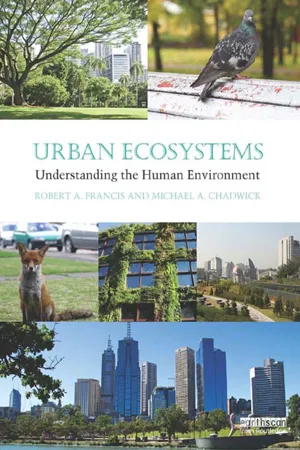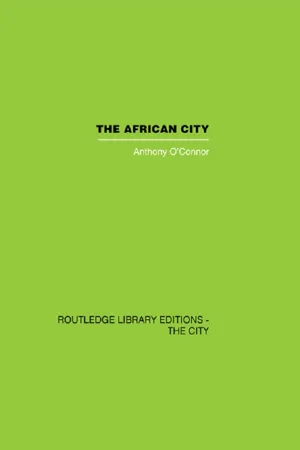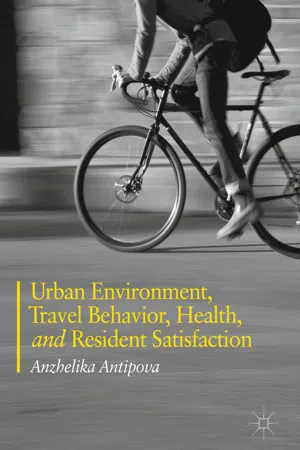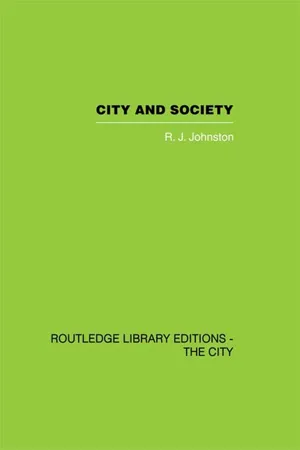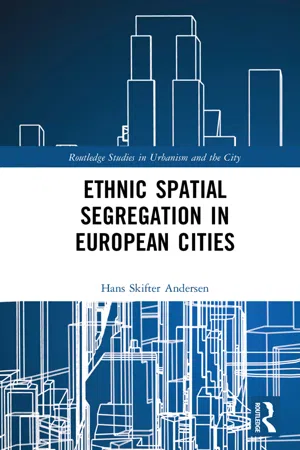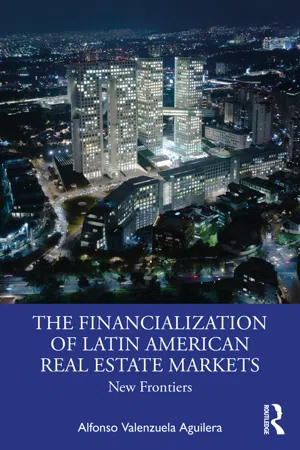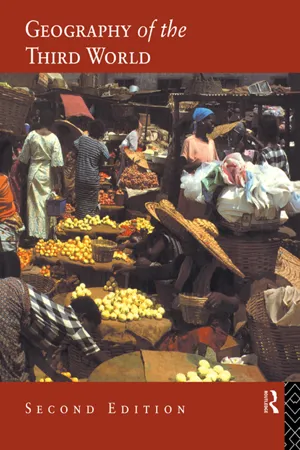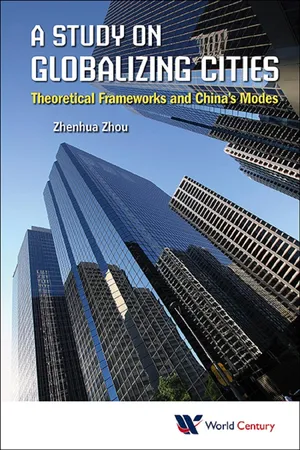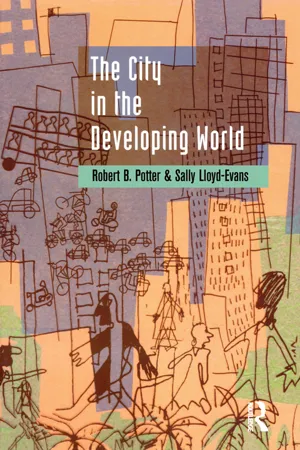Geography
Internal Structure of Cities
The internal structure of cities refers to the spatial organization and layout of urban areas, including the distribution of land use, infrastructure, and population. It encompasses factors such as zoning, transportation networks, and the arrangement of residential, commercial, and industrial areas within a city. Understanding the internal structure of cities is crucial for urban planning and management.
Written by Perlego with AI-assistance
Related key terms
12 Key excerpts on "Internal Structure of Cities"
- eBook - ePub
Urban Geography (Routledge Revivals)
An Introductory Guide
- David Clark(Author)
- 2013(Publication Date)
- Routledge(Publisher)
6 THE INTERNAL STRUCTURE OF THE CITY One of the most characteristic features of modern cities is their high level of internal differentiation. Sets of zones, communities or neighbourhoods are normally distinguishable in terms of physical appearance, population composition and related social characteristics and problems, and these are repeated from one city to another. The existence of similar social and residential patterns suggests that urban structure is determined by a number of general principles of land use and location. It points to the operation of powerful underlying social and economic forces which encourage similar, if not identical, uses for adjacent parcels of land across the city. The identification and explanation of internal patterns and processes is a major topic of inquiry in urban geography. A number of approaches have been followed by urban geographers in their attempts to understand urban spatial structure (Table 6.1). The first is essentially ecological and seeks to account for urban patterning in terms of the struggle for location and space in the city. It places particular emphasis upon compeition over territory between social groups and the ways in which this leads to the emergence of ‘natural’ areas in each centre. The tradeoff approach is grounded in neo-classical economics and explains intra-urban land use patterns in terms of the outcome of competitive bidding for land. Social area analysis and factorial ecology are extensions of the basic ecological approach which interpret intra-urban structures in terms of general theories of social and economic change. The conflict/management approach has roots in political science and the analysis of power and conflict in the city. It investigates the institutional structure of land use and development with reference to the role of urban managers and the nature of the constraints imposed upon individuals and groups within the city - eBook - ePub
Urban Ecosystems
Understanding the Human Environment
- Robert A. Francis, Michael A. Chadwick(Authors)
- 2013(Publication Date)
- Routledge(Publisher)
Despite being relatively well-planned and therefore spatially organised from a human perspective, urban environments are ecologically complex and heterogeneous in structure. This complexity depends upon the spatial scale considered, so that at the broadest scales particular typologies or patterns of urban form are observable, with implications for the ecology of the urban region. At finer spatial scales, patterns or trends in the arrangement of biotic and abiotic components can be observed (such as the density of buildings, gardens or street trees), again with related influences on urban ecology. Furthermore, urban environments are by nature dynamic, with relatively frequent changes in their physical fabric (e.g. construction and organisation of the built environment) and social organisation (e.g. as groups broadly defined by socio-economic or cultural characteristics shift location over time). Consequently, this chapter focuses on the different forms and structures of urban areas at different spatial scales, from the broad spatial layout and organisation of entire regions (including the formation of urban typologies), to the spatial organisation of landscape components within the urban complex. The biophysical dynamics of urban environments at each scale are also briefly discussed. Although this topic is vast and could form the basis for an entire book, and as such one chapter cannot provide comprehensive coverage, a broad overview of spatial organisation in urban regions is essential for developing an understanding of urban ecosystems and their ecology.2.2 Defining urban form and structure
The terms ‘urban form’, ‘urban structure’, ‘urban morphology’ and ‘urban fabric’ are often used interchangeably, and can refer to the spatial organisation of both physical and social parameters, such as housing density, arrangement of transportation networks, patterns of land use, population density or employment distributions (see, e.g. Tsai, 2005; Bramley et al. , 2009; Tian et al. , 2010). This chapter focuses on the biophysical components, rather than socio-economic or cultural characteristics, of urban regions, though of course the two are closely linked and some cross-discussion is required. ‘Urban form’ is considered here to refer to the broad spatial characteristics of an entire urban region. This includes the shape and arrangement of the urban complex(es) that represent urban land use within the region. ‘Urban structure’ is the spatial organisation of the urban complex at finer spatial scales (landscape to individualBox 2.1 Patch-corridor-matrix model
The discipline of landscape ecology focuses on interactions between landscape form and process, and how they may relate to landscape functioning. It has been dominated by the patch-corridor-matrix model of landscape structure since the model's initial publication in Forman and Godron's (1986) seminal text Landscape Ecology and its further substantive development in Forman's (1996) Land Mosaics - eBook - ePub
- Anthony O'Connor(Author)
- 2013(Publication Date)
- Routledge(Publisher)
7 Spatial structures
The diversity of people, economic activities and types of housing in African cities are all reflected in their physical forms and spatial structures. Just as there are many differences among cities, so also within each there are contrasts from one locality to another. Knowledge of one neighbourhood or ‘quarter’ may give a very false impression of the city as a whole. Yet the extent of such internal contrasts itself varies greatly from city to city.The physical form of the cities
One important set of factors is provided by the physical environment. The spatial structure of many cities has been influenced by a seaboard location, while others such as Khartoum (Figure 5 ) or Kinshasa (Figure 19 ) lie astride or beside a major river. The site of Lagos (Figure 14 ), originating on an island surrounded by lagoons and swamps, has severely constrained its physical growth, and created severe traffic problems. Freetown, strung along a narrow strip between mountains and the sea, faces a different set of constraints (Figure 23 ). Further examples are mentioned later.However, these environmental factors are often particular to individual localities, and few generalizations about their consequences can be made even for groups of cities. They must be given close attention in planning decisions for each city, but in this overview emphasis is placed on those recurring spatial patterns which reflect ideas and attitudes – and the contrasting urban traditions outlined in chapter 2.The greatest differences in physical structure, as in most respects, are between the pre-colonial cities and those which we have designated ‘European’ in origin. The Yoruba cities of Nigeria all share many features, while they differ hugely from cities such as Harare and Nairobi. They were designed by very different people, with very different aims and preconceptions. Among the contrasts in - Anzhelika Antipova(Author)
- 2018(Publication Date)
- Palgrave Macmillan(Publisher)
© The Author(s) 2018 Anzhelika Antipova Urban Environment, Travel Behavior, Health, and Resident Satisfaction https://doi.org/10.1007/978-3-319-74198-7_4Begin Abstract4. City Structure and Spatial Patterns
End AbstractAnzhelika Antipova1(1) The University of Memphis, Memphis, TN, USA4.1 Introduction
Urban models have a short history of development due to a need to process large data quantities which only became possible after the computer had been developed (Foot 1981 ). Methods for analysis of city structure and growth date back to classical models developed by the University of Chicago scholars in the 1920s. With the coming of computer technology beginning in the 1950s and 1960s, complex mathematical models were implemented to understand the development of urban environment, provide forecast, and exercise control. Studying the patterns of land uses within a city is not merely an academic exercise. Thorough understanding of the spatial patterns formed by residential neighborhoods and other land uses of the urban landscape is needed to solve the various urban issues including slum clearance, planning and zoning, or market analysis. This chapter provides a review of urban growth and urban system modeling. It starts with a review of the classic internal city structure models developed by urban sociologists. The chapter will next review urban spatial structure models.Population and employment suburbanization and improvements in transportation and communication have resulted in de-densification and horizontal expansion of urban areas (Rode et al. 2014 ) leading to a polycentric urban form in many cities (Gordon et al. 1998 ; Ingram 1998 ). Urban form and transport systems are interrelated (Smith 1984 ; Holtzclaw 2000 ; Rode et al. 2014 ), with high-density areas experiencing higher transport intensity including vehicle miles traveled (VMT) even when other factors are taken into account (Ewing et al. 2008- eBook - ePub
City and Society
An Outline for Urban Geography
- R.J. Johnston(Author)
- 2013(Publication Date)
- Routledge(Publisher)
This series of criticisms has engendered a debate within the whole of geography between, on the one hand, the spatial organization school and their behaviourist colleagues and, on the other, the structuralists who argue that study of spatial systems must be set within the context of the encompassing milieux. According to the latter group, the spatial organization approach implicitly accepts the current structure of society and its distribution of economic and political power. It describes the outcomes of the exercise of that power, but does not explain how power relationships circumscribe the framework for individual action. The results of spatial organizational studies pose questions about the manipulation of space by those with power in society, questions which cannot be answered with reference to space, and to transport costs, alone. Any planning based on the descriptions produced must ensure continuation of the power structure, and so is ideologically conservative. Creative change can be achieved only by understanding how society operates to structure space within the urban system, and then producing programmes which will affect the operations, not just the outcomes,City and society
The concerns of urban geography, then, are the organization of space within an urban context: what economic, social and political functions are conducted in which towns, and why; what trends are being operated to alter this distribution of functions; why different land uses are located in different areas within cities; and how and why these location patterns are changing. To date, much of the work by urban geographers has been concerned with sophisticated (at least in a technical sense) description of patterns and of trends, but there has been little work that offers satisfactory explanations for the urban phenomenon and its many characteristics. The major lack is of a general theory which explains how and why towns play a major role in contemporary society and how and why functions and activities are distributed between and within different urban areas. The present book attempts an outline for such a theory.Much of the structuralist critique of the types of urban geography practised in recent years, and still practised by most professed urban geographers, is accepted here. The patterns as described are not challenged; they are the basis for the theory, having asked the questions for which an answer is proposed. The basic theme followed here is that the city is a social artifact whose form can only be understood in the context of an understanding of the relevant society. The theory proposed is thus essentially a backward-looking one, seeking to explain the present through the past and treating the current urban phenomenon as the outcome of an evolutionary process. There is no discussion of the future, of what the system should look like. - No longer available |Learn more
- Meredith Marsh, Peter S. Alagona(Authors)
- 2023(Publication Date)
- Barrons Educational Services(Publisher)
(D) This region consists of a conurbation of linked cities such that, as you drive north or south along the coast in this region, you will always be driving through urban areas. These cities, at one time, were probably very geographically separate from one another but, because they have been increasingly expanded, have molded together into a megalopolis.Urban Planning
1.(C) According to Kevin Lynch, the five main elements contributing to a city’s legibility include paths, edges, districts, landmarks, and nodes. Links may exist in cities in the form of transportation systems, but they do not exist as one of the fundamental units that make cities more easily readable for their inhabitants and first-time visitors.2.(B) Action spaces are used by behavioral geographers to analyze individuals’ daily spatial activities. They describe all the typical interactions individuals have with their environment on any given day, and thus can provide insightful information for urban planners in making decisions on transportation routes and locations of various facilities within a city.3.(E) Behavioral geographers have analyzed numerous people’s action spaces to draw general conclusions about human spatial behavior on a daily basis. In general, this kind of behavior conforms to five rules: people take many more shorter trips than longer trips, most trips tend to be work-related, trips of greater distances require more thought and planning, travel decisions can be quite limited by transportation, and people tend to avoid perceived hazards when going about their daily activities.Free-Response
Historical Geography of Urban Environments
1.Main points:■The first cities arose in areas of early agriculture. As agricultural systems became increasingly developed, farmers were able to grow more than they needed of certain products. These excesses generated a trading system between farmers. Soon, not as many farmers were needed to produce the same amount of goods, and some began specializing in other functions that also served the community, such as carpentry, metalwork, and education. - eBook - ePub
- Hans Skifter Andersen(Author)
- 2019(Publication Date)
- Routledge(Publisher)
social mixing policies (Musterd and Andersson 2005). Some authors (Wessel 2000; Arbaci 2007; Musterd and Ostendorf 1998; Van Kempen and Murie 2009), however, have argued for more differentiated and context-bound explanations of segregation, where spatial characteristics of cities are included as important factors. One of these characteristics is the spatial housing structure, especially the segmentation of housing markets and the spatial separation of different housing tenures.The socio-spatial dialectic of cities
There has also been little focus on the dynamic changes that over time occur in cities creating new spatial structures and new kinds of segregation. The development of cities has occurred by an interaction between economic, social and physical changes. It has been called the socio-spatial dialectic (Soja 1980), a continuous two-way process in which people create and modify urban spaces while at the same time being conditioned in various ways by these changes. Neighbourhoods and housing, in which people prefer to live and work, or have access to, have changed continuously in pace with increased wealth and changing tastes. As a result, the social and physical structures of cities have undergone pronounced changes over the years. The growth of every city can be seen as a ‘twin process of outward extension and internal reorganisation’ (Knox 1995). While cities have been extended by new estates on the suburban fringe, existing urban areas have been subject to functional and physical changes; they have sometimes been converted to accommodate new uses. In some cases, existing physical structures have become obsolete and have deteriorated; in other cases they have been upgraded to meet new demands from more well-to-do residents. However, while the population composition of neighbourhoods can change over shorter periods of time – as a result of residential mobility or demographic processes (Van Ham et al. 2013) – changes in the physical fabric and the overall socio-economic status of neighbourhoods are much slower processes (Zwiers et al. 2015). - eBook - ePub
The European City
A Western Perspective
- D. Burtenshaw, M. Bateman, G. J. Ashworth(Authors)
- 2021(Publication Date)
- Routledge(Publisher)
CHAPTER 3Socio-Spatial Structures of Cities
A consequence of a distinctive history, national identity and ideology is a distinct social and spatial structure of the city in West Europe. Besides, the study of urban society has many of its origins in West Europe in the work of Tonnies, Weber, Booth, Engels and Marx. Studies of the social patterning of cities have evolved as rapidly as the paradigms in the social sciences, so that the descriptions of phenomena based on simple mapping techniques and simple causal relationships have given way to methodologies which, hopefully, clarify the complexities of spatial variations between and within areas of the city both at a given point in time and through time. Underlying the recent studies of social geography has been the fundamental search for a model of the social and spatial structure of the city in the western world. The result of this quest in West Europe has been a reaffirmation that the city possesses certain distinct social and spatial relationships particularly in the light of comparisons with the cities of North America. All too often such studies have been more concerned with perfecting techniques rather than making appropriate generalisations about the social structure of the city. Nevertheless, the outcome has been a move among research workers towards a greater understanding of the subjective nature of the urban environment by its citizens rather than the emphasis on supposed objectivity of the earlier studies. A more contemporary paradigm in the evolution of social area studies has been developed by those who see all social and socio-spatial divisions of the city as the product of the processes of social formation and the interplay of wealth, status and power. Despite the deep underlying differences between the methodologies of basic descriptive analysis, positivist approaches, behavioural studies and structuralism, they each draw attention not only to the common elements of the West European and other cities but also to the obvious differences. - eBook - ePub
- Alfonso Valenzuela Aguilera(Author)
- 2022(Publication Date)
- Routledge(Publisher)
Summarizing, city structure is shaped by economic forces through a series of arrangements and variations that may produce discontinuities, polarization, and disequilibrium in the territory. Financial instruments may affect the coherence of the city’s spatial configuration due to the scale and magnitude of the urban interventions that global capital can unleash. Analysis of key elements such as densities, land use, transportation costs, connectivity, and other external factors enable the identification of spatial growth patterns. Economic models are key to understanding the spatial structure of cities, which are subject to a specific social organization that considers space a commodity, an object of consumption, or as having both exchange and use-value. Urban planning instruments have also been used as ideological instruments for legitimizing public actions and private interests, meaning that, with the growing dominance of financial, capital investment begins to control the production of space through the incorporation of fictitious capital into the urban fabric, a subject we will introduce in the next chapter. These mechanisms affect the structural coherence of the city as infrastructure will no longer respond to the needs of citizens and will, instead, respond to the future value of financial assets.Urban economic theories provide a theoretical and general framework that may be useful for envisioning solutions to the urban challenges of geographic specialization, the intensity of land use, and land values. In this context, different dynamics, which involve centripetal forces and centrifugal impulses, shape agglomerations in which spatial rationality may be categorized. The concentric model has been key to understanding the different processes involved in city growth, by means of correlating labor categories to class divisions and identifying adaptation mechanisms. Also, spatial economics identifies processes of concentration and decentralization, turning the city into a catalyst for economic activities, in which densities, land use, and mobility are key factors. However, even when urban ecology models provide a framework for analysis of the structure of cities, they do not address a central issue, which is the identification of the socioeconomic processes that determine the location for different groups and activities within the urban structure. For instance, the radial sector model described the dynamics through which land prices and the cost of transportation play a key role in structuring the city, leading to the growth of business centers in locations other than the traditional city center, wherein retail may either decline or flourish depending on the economic dynamics, and suburban areas develop along mass transit lines. All of these economic features transform the physical configuration of the city and shape its structure. - eBook - ePub
- C.G Clarke, Dr J P Dickenson, J.P Dickenson, W.T.S Gould, S Mather, Sandra Mather, Prof R Mansell Prothero, R.M Prothero, D.J Siddle, C.T Smith, Mr C T Smith, E. Thomas-Hope(Authors)
- 2013(Publication Date)
- Routledge(Publisher)
Women working on a building site, India Internal Interaction Interaction and Spatial StructureAlthough the rural and urban areas of Third World countries and the agricultural and industrial sectors of their economies have been examined in their own right in the preceding chapters, they are not independent of each other, but interact as part of a spatially and economically cohesive whole. Incomes from crop production stimulate rural demand for industrial and consumer products, which in turn have an effect on the urban economy by creating jobs and stimulating commerce, while industrial growth in the towns may stimulate the rural sector. Expansion of cotton textile production, for example, will mean not only more jobs in urban areas and increased rural–urban migration, but will stimulate an increase in cotton production by local farmers. Separately, town and country, industry and agriculture, comprise the essential building blocks of the human geography of any country. Together they are linked in the development process through a network of urban regions, arranged hierarchically, both internally and with respect to the international economy. Exchange or interaction between them is integral to the process of development or under-development. In this chapter we consider why and how distinctive patterns of interaction have developed within Third World countries, and with what effect on the movement of goods, services and people.The essential features of any spatial structure are nodes, linkages and hierarchies. Nodes are points of exchange and control, and emerge at points of accessibility through linkages (roads, telecommunications, etc.) with their hinterlands. These nodes are not only related to each other through other linkages, but also tend to be arranged in hierarchies. The levels of the hierarchies are themselves dependent on linkages with levels above and below. The most obvious type of interaction occurs through the linkages of the transportation system, by road, rail, air, river, lake and sea. In the case of transport, the linkage is the road or railway (or the ‘invisible’ sea route), and the nodes are the railway stations, ports and airports; the hierarchy - eBook - ePub
Study On Globalizing Cities, A: Theoretical Frameworks And China's Modes
Theoretical Frameworks and China's Modes
- Zhenhua Zhou(Author)
- 2014(Publication Date)
- WCPC(Publisher)
Furthermore, in the global urban areas, various global cities, characterized by the supra-national spatial relations as different global city nodes, have their own characteristics, status, and functions. Therefore, different from urban areas with a single core, the global city region is often a spatial structure of an urban expansion joint with multicore (center). There still exist controversies over this “multicenter” spatial structure, manifested as being a circle, or a band, or other forms. Hall believes that the global city region should have a multicenter circle spatial structure. The core is the central business district, such as the City of London, Chatelet, Marunouchi/Otemachi, etc. Located slightly outside is the new central business district, such as the West End, Paris district 16, Akasaki/Rippongi, etc., having a high concentration of certain types of office activities (especially, headquarters) and entertaining or cultural activities. Then is the inner edge city, mainly peripheral expansion of industrial and commercial sites, little away from the first and second levels of the center, such as La Défense, Canary Wharf, World Financial Center, Shinjuku, and Potsdam Square, highly concentrated with the new office space and entertainment venues; then further outside are outer edge cities, composed of some transport node towns, becoming a linking point of the central city’s contact with the outside areas, such as London’s Western Sector, Roissy, Kista-E4 Corridor, Amsterdam-Zuid, etc., the external part of which is called the “edge of the urban complex”, concentrated with some of the main downtown business R&D departments or the “back offices”, such as Crow Yin Dayton , Reading, Cergy-Pontoise, Omiya, Kawasaki, Greenwich (CO). In the furthest outer urban areas are present, specialized sub-grade centers in compliance with the division of geographical labor, which provide the central city and other spheres with education, entertainment, and business and exhibition services such as stadiums, amphitheaters, convention and exhibition centers, and theme parks), such as the Greenwich Millennium Dome, Paris Disneyland, Tokyo waterfront areas, etc. As for the “multicenter” spatial structures, as described by Hall, they can still be discussed further and brought into empirical investigation. But no matter what kind of form the spatial structure takes, there are several definite points, i.e., they create not the traditional single central city but a new polycentric urban form; they are located in some nodes, although fairly dispersed from the center to the edge; the multiple centers are based on the internal relations of specialization, respectively, playing different roles, not only cooperating but also competing with each other, forming a very unique urban areas in space. In this sense, the formation of the global city region of the circle and professional transformation of the circle is conducted simultaneously.4.2. Interpretation of the Spatial Structure for Regions of Global Cities
In the context of globalization and information technology, the formation and development of the global city region has increasingly become the basic spatial units of the contemporary global economy, which is a very significant change. This change needs a corresponding theoretical explanation. The traditional city or global city theory is a single center-based geographical space, the analytical framework of which has been unable to expand the global city region to fully explain the unique spatial structure. Therefore, we must seek new theories and methods to analyze the global city region, to grasp the spatial structure of the new changes.4.2.1. Re-examining the spatial structure of traditional urban theory
As we have pointed out earlier, the mainstream theory of global city derives the hypothesis of global cities directly from globalization, the specific context of information, and therefore the view of its research tends to focus on the impacts of globalization and informatization on the global cities. This not only ignores the general impact of globalization and informatization on ordinary cities (as previously commented earlier) but also actually implies the use of the concept “traditional single central city” and its further expansion. - eBook - ePub
- Robert B. Potter, Sally Lloyd-Evans(Authors)
- 2014(Publication Date)
- Routledge(Publisher)
8 ). As earlier chapters have elucidated, developing world cities are increasingly diverse. They have their own unique histories of development which have been influenced by different stages of development, from colonial rule through to their current position in the post-colonial global economy. Thus, we should expect urban morphology to be diverse.As this chapter will demonstrate, colonialism has played a major role in shaping the internal organisation of cities across the developing world. Socially segregated cities were developed by various European powers from the 1500s onwards, as trading or administrative centres, depending on their size and strategic location. In the post-colonial era, however, cities have been affected by their economic role in respect of their national, regional and global positions as industrial, financial or political centres. Of course, we must not underestimate the importance of macro-economic processes, such as the New International Division of Labour and structural adjustment, in shaping the built environment and the social stratification of cities.Recently, cities in the Newly Industrialising Countries (NICs) of Asia and Latin America have become focal points for Foreign Direct Investment (FDI), manufacturing branch plants and the headquarters of multinational enterprises, as covered in Chapter 3 . Growing consumer markets are demanding modern transport and better urban services. City structure also differs according to a country’s ability to undertake the structural transformation, in terms of employment, housing and infrastructure, needed to accommodate increased population. The 1980s debt crisis halted many new plans for urban redevelopment along with the expansion of infrastructure.An often under-explored facet of urbanisation has been the introduction of modern transport systems which fundamentally alter the location of industry and residential areas, and disrupt traditional social structure (Chokor, 1989). Most cities have a heterogeneous range of formal and informal transport systems which serve different sectors of the population (Hilling, 1996; Simon, 1996). As Simon (1996: 93) argues, transport systems ‘need to be understood in terms of the history, culture and functions of each city’. For example, the development of international airports, motorways and mass rapid transit systems (MRTSs) has dramatically altered the social and economic structure of some large cities in recent decades.
Index pages curate the most relevant extracts from our library of academic textbooks. They’ve been created using an in-house natural language model (NLM), each adding context and meaning to key research topics.

